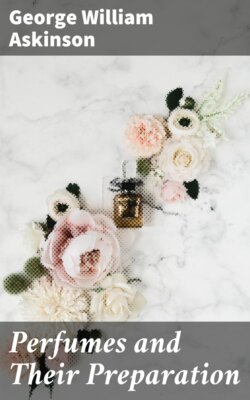Читать книгу Perfumes and Their Preparation - George William Askinson - Страница 6
CHAPTER II.
ABOUT AROMATIC SUBSTANCES IN GENERAL.
ОглавлениеWe apply the term perfume—which really means a fumigating material—to those substances which make an agreeable impression upon our sense of smell; the French call them briefly odeurs, i.e., odors. The high degree of development at present attained by this industry in France and England is the cause of the fact that all perfumes are generally sold under French or English names, which must be borne in mind by manufacturers in this country.
Perfumes or scents, however, exert not only an agreeable impression on the olfactory organ, but their effect extends to the entire nervous system, which they stimulate; when used in excess, they are apt to cause headache in sensitive persons; the laborers in the chemical factories where these substances are produced on a large scale, occasionally even suffer by reason of their stimulating action on the nerves. For this reason perfumes should never be employed otherwise than in a very dilute condition; this necessity arises from a peculiarity of the odorous substances which when concentrated and pure have by no means a pleasant smell and become fragrant only when highly diluted. Oil of roses, of orange flowers, or of jasmine, in fact nearly all aromatic substances, have an almost disagreeable odor when concentrated; only in an extremely dilute state they yield those delightful scents which we admire so much in the blossoms from which they are derived.
It will be easier to understand the almost incredible productiveness of perfumes if we cite as an instance that a few centigrams of musk placed on a sensitive scale can for years fill a large hall with their characteristic odor without showing an appreciable loss of weight, and still particles must separate from the musk and become evenly diffused through the air of the hall because the odor is perceptible throughout every part of it.
It would be an error, however, were we to assume that all aromatic substances possess the same degree of productiveness; some of them, as for instance the odorous principle of orris root, have a comparatively faint smell—a fact which must be borne in mind in the combination of perfumes. Even odors having a very similar effect on the olfactory nerves differ widely in their intensity; for instance, true oil (attar) of roses possesses an intensity more than twice as great as that of the rose geranium; many authorities agree in giving the proportion as three to eight, the first figure being that of rose oil, the second that of oil of rose geranium. Therefore, in order to produce perfumes of equal intensity (having the same effect on the olfactory nerves), we must dissolve in an equal quantity of the menstruum either three parts by weight of the attar of roses or eight parts of the oil of rose geranium.
In the prescriptions for the preparation of perfumes given in this book, these proportions have been carefully weighed; but it will be the office of the trained olfactory sense of the manufacturer to modify them for the various kinds of perfumery in such a way as to produce a truly harmonious pleasant odor.
Although we know many aromatic substances, we are still in ignorance as to the preparation of certain decidedly agreeable odors. Thus no one at present is able to produce the refreshing odor of the sea borne along on the wind, any more than we are able to reproduce the scent exhaled by the forest, especially after a warm rain; chemistry, though it has done much in the domain of perfumery, has thus far thrown no light upon it. Even certain vegetable odors—for instance, the delightful perfume exhaled by some Aroideæ and Primulaceæ—we cannot as yet preserve unchanged in perfumery. This opens an illimitable field for future activity to the progressive manufacturer.
In a book devoted to the production of perfumes it would certainly be in place to say something about the physiological relations of the olfactory sensations; but unfortunately this interesting part of physiology is still enveloped in great obscurity. All we know positively on this subject is that many particles of the odorous bodies evaporate and must come in contact with the olfactory nerves in order to produce the sensation of odor. There is no lack of experiments seeking to draw a parallel between sensations of smell and those of hearing, and, as is well known, we speak of a harmony and dissonance of odors as we do of tones. Piesse, the renowned perfumer, has even made an attempt to arrange the different odors in a “harmonic scale” having the compass of the piano, and to deduce therefrom a law for the mixture of the several aromatic substances. This attempt, although very ingenious, still lacks a scientific foundation. Piesse endeavors to combine the several scents like tones to produce chords in different scales; the chords of odors are to agree with those of tones. Thus far, however, no proof has been furnished that the olfactory nerve and the acoustic nerve have the same organization, and under this supposition alone could Piesse’s system be accepted as correct.
